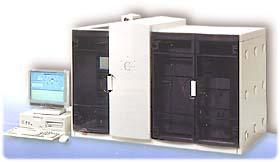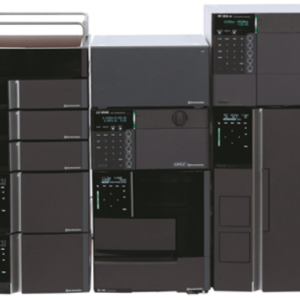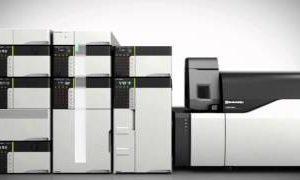i-Series
Новейшие модели моноблочных жидкостных хроматографов i-серии LC-2050/LC-2060 унаследовали превосходные характеристики двух предыдущих моделей Prominence-i/Plus и Nexera-i/Plus и включили концепцию «искусственного интеллекта», впервые заявленную в серии LC-40 Nexera.
- Описание
- Особенности
- Применение
- Характеристики
Описание
Жидкостные хроматографы LC-2050/LC-2060 обеспечивают надежные и достоверные результы анализа. Программное обеспечение LabSolutions Direct и LabSolutions CS позволяет выполнять серийный анализ, находясь за пределами лаборатории (управлять прибором, выполнять анализ, проводить мониторинг и анализ данных), что увеличивает эффективность работы лаборатории.
Откройте для себя новые возможности анализа с помощью усовершенствованной линейки жидкостных хроматографов i-серии.
ВЭЖХ: модельный ряд жидкостных хроматографов LC-2050
(рабочее давление 50 МПа)
Модели отличаются детекторами (спектрофотометрический, диодно-матричный или без детектора) и возможностью охлаждения образцов.
| Наименование модели | Охлаждение образцов | Детектор |
|---|---|---|
| LC-2050 | Спектрофотометрический | |
| LC-2050C | √ | Спектрофотометрический |
| LC-2050C 3D | √ | Диодно-матричный |
| LC-2050C LT | √ | Без детектора |
УВЭЖХ: модельный ряд жидкостных хроматографов LC-2060
(рабочее давление 70 МПа)
Система переноса метода обеспечивает отличную поддержку для выполнения методов УВЭЖХ и ВЭЖХ на одном хроматографе.
| Наименование модели | Охлаждение образцов | Детектор |
|---|---|---|
| LC-2060C | √ | Спектрофотометрический |
| LC-2060C 3D | √ | Диодно-матричный |
| LC-2060C 3D MT∗ | √ | Диодно-матричный |
Особенности моделей
Инновационность
Дистанционное управление хроматографами и мониторинг позволяют выполнять аналитические операции удаленно, сокращая тем самым время, проводимое в лаборатории
Интеллектуальность
Дополнительные возможности, увеличивающие эффективность работы лаборатории:
— Интерактивное управление прибором минимизирует работу оператора и освобождает его от проведения ежедневных рутинных операций
— Функции автоматической интеграции i-Peak Finder и деконволюции пиков i-PDeA II
— «Бесшовный» перенос и адаптация аналитических методик, разработанных для различных моделей ВЭЖХ (функция ACTO)
Интуитивность
Интеллектуальное управление, обеспечивающее максимальную надежность:
— функция MPM: измерение количества подвижной фазы в режиме реального времени. Хроматографические системы проводят гравиметрический мониторинг растворителей и предупреждают оператора, если подвижной фазы недостаточно для завершения серии анализа
— функция FlowPilot: постепенное увеличение скорости потока до заданного значения для предотвращения повреждения колонок при внезапных пусках, остановках насоса, а также при резких изменениях градиента
— функция M2M: отслеживание использования расходных материалов по номеру детали и предупреждение оператора по электронной почте о необходимости их замены
► Моноблочные жидкостные хроматографы i-серии, листовка
► Моноблочные жидкостные хроматографы i-серии, брошюра (англ. яз.)
Особенности
i-Series Features
Automation and Remote Operation/Monitoring that Encourage a New Working Style
With FlowPilot, mobile phase monitoring, and other functions, that engineered by Analytical Intelligence, and LabSolutions™ Direct can provide an automated workflow together with remote operation and monitoring from instrument startup to analysis completion.
Automated workflows incorporate the operational expertise of experienced analysts in order to collect data over extended period of time, reduce activities that must be performed in the laboratory, and improve work efficiency.
Using Networks for More Improvements in Work Efficiency
LabSolutions CS allows remote operation and monitoring of all instruments on the analytical network from any locations, even from home.∗ Analysis data and reports are managed on a centralized database where administrative authorization allows managers to assign appropriate operational restrictions to operators, depending on their expertise and rank.
∗ Must have a network in place that is appropriate for the workflow.
Mobile Phase Monitoring
Preventing Mobile Phase Depletion for Continuous Analysis
Mobile phase monitoring function∗1,∗2 automatically monitors mobile phase volumes so multiple analyses can be performed continuously without fail. If the monitoring function detects, either before start of analysis or during analysis, that a mobile phase is likely to become depleted, a notification is sent to the operator’s computer or smart device to recommend replenishment. This removes the need for repeated instrument checks and mobile phase replenishment and thus prevent re-analysis, therefore prevents any system downtime.
∗1 Optional
∗2 Monitors up to 12 liquids when using 1-liter bottles, and up to 4 liquids when using large-volume bottles (2- to 5-liter bottles).
Mobile Phase Flowrate Control Function
Automating Manual Operations for Experienced Users
The i-Series auto-startup and mobile phase flowrate control function (FlowPilot) can start instruments automatically without burdening the instrument or consumables. This prevents system breakdown and reduces operational cost, while providing highly reliable data over extended period of time.
Remote Operation/Monitoring Function
Operate and Control Instruments from Outside the Laboratory
Using LabSolutions Direct, instruments can be operated remotely to implement pre-configured methods and batch analyses from remote locations outside the laboratory from the web browser of a computer or a smart device.
Instrument status and chromatogram can also be monitored remotely to reduce the time and labor required to travel to and from the laboratory and improve the work efficiency of analysts.
intelligent
Applications for Analytical Intelligence are not limited to automating the analytical workflow or remote operations. By aggregating and automating the knowledge and skills of experienced analysts, Analytical Intelligence enables anyone to obtain reliable data and analytical results.
Analytical Intelligence is also designed for high levels of compatibility with other instruments and comes with a method migration function, thereby creating a work environment where anyone is equally capable to obtain data without the need for complex procedures to resolve the compatibility between different systems.
i-PeakFinder Automatic Peak Integration Function
Process Large Volumes of Data with High Precision in a Single Step
Processing baseline undulation and noise-obscured peak is a labor-intensive process that can lead to different results based on the experience level of the analyst. Shimadzu’s proprietary i-PeakFinder peak integration algorithm is perfect for troublesome chromatograms like this.
The i-PeakFinder algorithm is designed to process large volumes of data with high precision in a single step, thereby enabling the user to interpret data acquired more rapidly through simultaneous analysis of multicomponent analytes.
ACTO Method Migration Support Function
Supporting Instrument Replacement and Method Migration
Migrating a test method (analytical conditions or method) from one instrument to another while obtaining the same chromatogram can be a challenging process. The i-Series is designed with the same internal system volumes as previous Shimadzu systems and competitor systems to ensure system compatibility, and data reproducibility. An Analytical Condition Transfer and Optimization (ACTO) function also adjusts gradient start time automatically, hence analyst can make adjustments to separations obtained by gradient analysis easily.
i-PDeA II Peak Deconvolution Function
Preventing Components being Missed Due to Inadequate Separation
The i-PDeA II peak deconvolution function uses a multivariate curve resolution alternating least squares (MCR-ALS) method to enable qualitative and quantitative analysis of peaks not fully separated by the column. The i-PDeA II can also be used to check the purity of target peaks. (Only available when using a PDA detector and LabSolutions.)
intuitive
User Interface
Simplifying i-Series Operation
The user interface replicates system flow channel and is used to visually check the operating status of the system. Method editing can also be performed from the same screen. With its intuitive design, even users who are completely new to liquid chromatography can navigate the user interface with minimal training.
Maintenance Videos
Supporting the Replacement of Consumables
Reading a QR Code® shown on the touch panel directs the user to a website with instructional videos on maintenance. This feature helps improve system availability and increases efficiency.
Auto-Validation Function
Stable Operation from System Startup
An auto-validation function means anyone can follow a set procedures and verify the instrument condition easily. The auto-validation function examines solvent delivery stability, wavelength accuracy, absorbance accuracy, gradient accuracy, the presence of any drift/noise, and other parameters. Also, an instrument check function automatically carries out the routine inspections performed before instrument operation and creates a report showing system self-diagnostic results along with a record of consumables usage, including total solvent volume delivered by the delivery pump, total number of injections performed by the autosampler, and the number of hours the lamp has been illuminated. The system check function also manages auto-validation results, making it easy to accurately determine the operating status of the instrument.
Starting Auto-validation
Procedures, mobile phases, and other information necessary for validation are displayed on the screen, allowing you to perform inspections by simply following the instructions.
Creating a System Check Report
Validation results can be viewed from the i-Series main unit. Validation results can also be output in a report format from a workstation.
Open Access Sample Placement
A direct access mechanism on sample racks allows the user to place the sample on racks that are not involved in sample injection even during analysis. Furthermore, racks can be shared by multiple analysts, without interrupting the analysis of samples placed by others. Overall, this function enhances work efficiency.
System Monitoring via Smart Devices
System status and chromatograms can be viewed remotely from smart devices and home computers. Situations can be checked without needing to visit the laboratory.
Dual-Temperature Control with TC-Optics and Flow Cells
Excellent Baseline Stability
In addition to the temperature control function for flow cells, the i-Series employs new temperature control technology for detector optical systems, known as TC-Optics (Temperature Controlled Optics). This ensures a more stable baseline that is less susceptible to room temperature variation and increased precision during verification testing and quantitative testing of trace components.
Ultra-Low Carryover Performance Enables High-Sensitivity Analysis
Improved Reliability of Trace Component Analysis
Shimadzu’s proprietary flow channel design, parts, and materials reduce the carryover effects of sample residue to almost zero. Ultra-low carryover performance has been improved to 0.0025% (chlorhexidine, assigned conditions), thereby providing highly precise quantitative performance when analyzing complex samples.
Применение
i-Series Applications
The LC-2050 and LC-2060 are compatible with applications designed for the original i-Series. Applications for the LC-2030/2030 Plus can be carried out with the LC-2050, and those for the LC-2040/LC-2040 Plus with the LC-2060.
Pharmaceuticals
The i-Series supports a wide range of HPLC analyses in the pharmaceutical industry, from identification and purity testing at the drug discovery stage to impurity testing and quantitative determination at the manufacturing and quality assurance departments.
Standard performance features, such as excellent baseline stability, ultra-low carryover performance, and excellent reproducibility of sample injection, ensure stable and validated results in any analysis based on national Pharmacopeia of each country.
Foods and Beverages
The i-Series supports a wide range of HPLC analyses in the food and beverage industry, such as active ingredient analysis and toxic substance analysis.
Systems with a PDA detector are ideal for the analysis of synthetic pigments. Qualitative analysis with a UV spectrum and sensitive and simultaneous quantitation by wavelength switching are available. By adding an optional tungsten lamp, synthetic pigments and other substances measured in the long-wavelength region can be detected with high sensitivity.
The temperature of the oven can be controlled to as high as 85°C, while still allowing effective analysis, such as that of sugars in ligand exchange mode. Adding the RF-20Axs differential refractive index detector enables the detection of low light-absorbing compounds such as sugar.
Furthermore, adding the ELSD evaporative light scattering detector enables detection of low light absorbing components with a gradient elution method. A remarkably wide range of applications is possible, including simultaneous analysis of multiple components.
Environmental
The i-Series supports a wide range of HPLC analyses in the environmental industry, water, atmospheric and soil analysis.
Analyses of environmentally hazardous substances require high-sensitivity simultaneous detection. Connecting a world-class sensitive fluorescence detector, RF-20Axs, to a system equipped with a UV detector increases detection selectivity and sensitivity, and ensures reliable detection and identification of trace-level of environmental contaminants.
Chemicals
The i-Series supports a wide range of HPLC analyses in the chemical industry, from small molecules to polymers.
Since the i-Series column oven accommodates multiple 30 cm columns, adding a differential refractive index detector enables GPC analysis of hydrophobic polymers and other materials. In addition, «LabSolutions GPC software» facilitates molecular weight distribution calculation. For trace amounts of light-absorbing additives in samples, a UV or PDA detector can be used complementarily.
Характеристики
Технические характеристики LC-2050C
Насос
| Дегазатор |
Пять линий дегазирования: подвижная фаза 4 + раствор для промывки 1 [объём 400 мкл] |
|---|---|
| Тип насоса |
Параллельный двойной плунжерный |
| Пульсация давления |
≤ 0,1 МПа [1,0 мл/мин,10 MПа, вода] |
| Диапазон скорости потока элюента |
от 0,0001 до 10 мл/мин |
| Точность установки скорости потока |
≤ ±1% или ≤ ±2 мкл/мин, (ниже большего значения) |
| Точность отображения давления |
< 0,06 %RSD или < 0,02 minSD, (ниже большего значения) |
| Конфигурация |
С установленной системой градиента по низкому давлению максимально по 4 компонентам |
| Градиент / диапазон установки концентраций |
от 0 до 100%, шаг 0,1% |
| Градиент / точность |
±0,5% [от 0,1 до 2 мл/мин, от 1 до 20 MПа, специальные условия] |
| Градиент / точность задания концентрации |
±0,1% [1 мл/мин,10 MПа, специальные условия] |
| Максимальное давление |
50 MПа [от 0,0001 до 5 мл/мин] |
| Мертвый объём |
650 мкл |
Автодозатор
| Система ввода образца |
Полное дозирование образца |
|---|---|
| Точность дозирования |
±1% [50 мкл, N = 10] |
| Объём дозируемой пробы |
от 0,1 до 100 мкл |
| Воспроизводимость объёма пробы |
RSD < 0,20% [5,0−2000 мкл] |
| Перекрёстное загрязнение |
0,0025% [кофеин, специальные условия] |
| Время ввода образца |
мин. 14 с [специальные условия] |
| Ёмкость автодозатора |
336 виал объемом 1 мл; 216 виал объемом 1,5 мл; 112 виал объемом 4 мл; 4 микротитрационных планшета с 384 лунками |
| Диапазон установки температуры |
от 4 до 45°C |
| Линейность |
> 0,9999 |
Термостат колонок
| Тип |
Принудительная циркуляция воздуха |
|---|---|
| Вместимость |
До 6-ти колонок длиной 10 см, до 3-х колонок длиной от 10 до 30 см |
| Диапазон контроля температуры |
от (комнатная температура − 12°C) до 90°C |
| Диапазон установки температуры |
от 4 до 90°C, шаг ±0,1°C |
| Стабильность температуры |
±0,8°C (специальные условия) |
| Дополнительные возможности |
Установка одного крана переключения потока подвижной фазы |
Спектрофотометрический детектор
| Диапазон длин волн |
от 190 до 700 нм |
|---|---|
| Ширина спектральной щели |
8 нм |
| Точность установки длины волны |
≤ ±1 нм |
| Воспроизводимость длины волны |
≤ ±0,1 нм |
| Шум |
≤ ±2.5 × 10−6 AU, (250 нм, специальные условия) |
| Дрейф |
≤ 100 × 10−6 AU/h [250 нм, специальные условия] |
| Одновременный просмотр по двум длинам волн |
Допускается [Любые две длины волны от 190 до 370 нм или от 371 до 700 нм] |
| Линейность |
До 2,5 AU (5%) |
| Частота сбора данных |
До 100 Гц |
| источник света |
Дейтериевая лампа (D2) |
| Стандартная ячейка |
12 мкл (10 мм, термостатируемая), 12 МПа |
| Дополнительные ячейки |
Высокоскоростная: 8 мкл [10 мм, термостатируемая] |
Другие характеристики
| Размеры |
Ш410×В605×Г500 мм [не включая поддон для бутылей] |
|---|---|
| Масса |
63 кг |
| Диапазон pH |
от 1 до 13 |
| Материалы, контактирующие с подвижной фазой |
Нержавеющая сталь (SUS316L, SUS316), FEP, PEEK, PTFE, перфторэластомер, рубин, сапфир, сплав Hastelloy® C, GFP, керамика, PFA, кварц, PPS |





